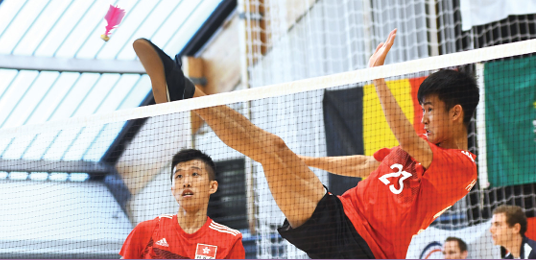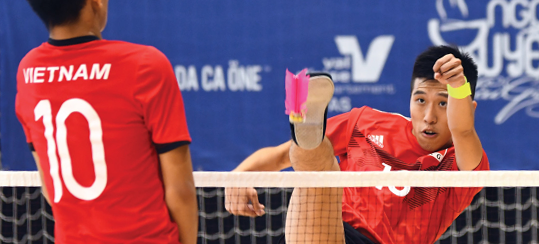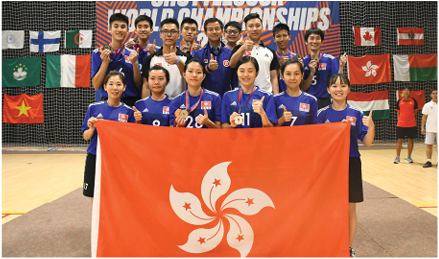 Leisure and Cultural Services Department - Community Sports Club BulletinLeisure and Cultural Services Department
Leisure and Cultural Services Department - Community Sports Club BulletinLeisure and Cultural Services Department
Sports Recommendation
Shuttlecocks
Most of you must have played shuttlecocks in childhood. Originated in China, shuttlecocks have a history of over a thousand years. There are varying ways to play shuttlecocks, one of which is similar to playing volleyball. Players manoeuvre shuttlecocks with catches, passes and attacks, with an aim of keeping them in the air without hitting the ground. The rules for shuttlecocks seem to be simple enough for beginners to learn, but it is actually difficult for one to become highly skilled in the sport. Playing shuttlecocks can be challenging in a sense that beginners easily kick shuttlecocks too far. That said, once getting the hang of things, you will enjoy the fun of the sport, which has mesmerised many with its fast-paced and exciting games.
Origin of Shuttlecocks
With a long history, shuttlecocks have actually evolved from “Cuju”, a game played among ancient soldiers and purportedly invented as early as during the ancient Huangdi era. It is no doubt a sport with particularly distinctive traditional cultural features. Upon evolution across dynasties, shuttlecocks had become a popular sport suitable for all round the year during the Ming Dynasty. Later, in the Qing Dynasty, shuttlecocks have gained even greater popularity among people from all walks of life, and freestyle shuttlecocks emerged at that time. Today, there are three major ways of playing shuttlecocks, namely circle play, freestyle shuttlecocks and shuttlecock sport.
Three Major Ways of Playing Shuttlecocks
Circle play, the most common one among shuttlecock players, is probably what people think of first when mentioning shuttlecocks. Many have played this game when they were small. At the start of the game, players will first form a circle, and then a player will kick and pass the shuttlecock, made of newspapers and feathers, to the next player.
Freestyle shuttlecocks demand players to perform various tricks according to specified requirements, and such tricks are called “taolu”, which is also known as routines. There are marked differences between the northern and southern schools of freestyle shuttlecocks in the aspects of movement requirements and jumping intensity.
Shuttlecock sport is a high-intensity competitive sport encapsulating the elements of football skills, badminton courts and rules for volleyball, thereby epitomising the essence of various sports.
Benefits of Playing Shuttlecocks and Points to Note
Shuttlecocks are well-renowned for its wide variety of competition modes and various rules for playing, making it a perfect sport for all. The most remarkable and immediate benefit of playing shuttlecocks is to improve both physical fitness and motor co-ordination. In addition, the sport may enhance muscle and tendon flexibility as well. Teaming up to participate in competitions allows players to learn how to communicate and co-operate with others, thereby cultivating team spirit.
Playing shuttlecocks demands a very high level of body flexibility. To prevent tendons and muscles from getting strained, one must do warm-up before getting into the sport. During training, participants should pay attention to their own physical conditions, while doing cool-down after exercise.
Development and Promotion of Shuttlecocks in Hong Kong
Despite the fact that shuttlecocks are a long-established sport, the Hong Kong Amateur Shuttlecock Association (Association) was founded as late as the 1980s in Hong Kong. Upon establishment, the Association jointly organised the “Urban Council Cup Shuttlecock League” and the “Urban Council Cup Shuttlecock Tournament” with the then Urban Council on an annual basis. Over the years, the Association has strived to promote the development and exchange of the sport. In 1986, at the invitation by the Guangzhou Shuttlecock Association, the Association fielded a team to represent Hong Kong to compete in a competition held in Guangzhou. Since then, there have been more frequent exchanges between the two cities as part of a joint effort to promote the sport.
In 1994, the Association was renamed the Hong Kong Shuttlecock Association after restructuring. Thanks to years of hard work and campaigning in promotion of the sport by the Association, shuttlecocks were officially included in the Primary School Physical Education Curriculum in 1999. In light of the huge popularity of the sport in Hong Kong, the Association launched its second restructuring in a bid to rename itself as the “Hong Kong Shuttlecock Association Limited” in 2007. Since then, the Association has committed to nurturing more elite athletes to represent Hong Kong in various competitions. Over the years, such local shuttlecock athletes have been competing all around the globe and achieving notable results. In 2017, Hong Kong hosted the World Shuttlecock Championships for the first time with an overwhelming response. In addition, the LCSD provides subsidies to the Association for organising the “Elementary Shuttlecock Training Course” and the “Shuttlecock Skills Enhancement Course”, each with five classes, on an annual basis. Meanwhile, shuttlecocks have been included in the School Sports Programme, in the hope of giving wider publicity to the sport.
Rules of Playing Shuttlecock

- Shuttlecocks are played on a rectangular court of 11.88 metres in length by 6.1 metres in width. The court must have an unobstructed clearance of 6 metres from the ground level and 2 metres from each of its side.
- The vertical distance of the top-middle part of the net above the ground must be 1.5 or 1.6 metres.


Team Events
- Each team is comprised of six players, with three players on the field at a time. One player is designated as the captain who will wear an armband with a conspicuous marking for identification.
- Prior to the start of a match, each team should complete the line-up sheet and register the names and numbers of its players, including substitute players, on the scorecard. Those failing to register will not be permitted to participate in the competition.
- Each team will be allowed up to two substitutions per game.
Doubles
- Each team is comprised of two players. One player is designated as the captain who will wear an armband with a conspicuous marking for identification.
- Each team should register the names and numbers of its players, as well as the order of service on the scorecard. Those failing to register will not be permitted to participate in the competition.
- In case a player from one side cannot continue to play in a match, whatever the reasons, it will be considered as having insufficient players available, and the team in question will be declared a losing side.


- Each match is played to the best of three games and each game is played to 21 points.
- The rally point scoring system is adopted in each game. A coin toss by the referee determines which side of the court teams will start on and which team will serve first. Service then alternates between teams for the remainder of the match.
- In case either side’s score reaches 10 in a tie-break, the teams must change ends before continuing with the game.
- Players are allowed to hit shuttlecocks with nothing but head, torso, legs and feet. Doing so with hands and arms is not permitted.
- Each team is entitled to a maximum of four hits before returning shuttlecocks to the opponent’s court.
- Each player must not hit shuttlecocks for three times or more in a row.
- In the event of a 20-20 tie, the right to serve must alternate, regardless of which team won the previous rally, until the tie is broken, meaning that a team must score 2 clear points to win the game.

Introduction to Basic Skills
Players must master the “four basic skills”, namely inside kick, outside kick, instep kick as well as thigh or knee kick, before kicking shuttlecocks high in the air.

- Place your centre of gravity over your supporting leg and slightly bend your knee before kicking shuttlecocks
- As shuttlecocks fall, turn the knee of your kicking leg outwards and use your thigh to exert power, while keeping your toes pointing forward, to kick the shuttlecocks up with the inner side of your kicking foot at a horizontal angle
- Kick shuttlecocks at a level slightly below the knee of your supporting leg
- Upon coming into contact with shuttlecocks, lift your kicking leg up to propel them to the designated location

- Use the thigh of your kicking leg to exert power to lift the lower leg up while turning the knee inwards. Then, lift the outer side of your kicking foot vertically upwards at your side
- Point the toes of your kicking foot forward so that the outer side of the foot is level with the ground and facing upwards
- Kick shuttlecocks with the rear half of the outer side of your kicking foot
- When coming into contact with shuttlecocks, kick them up using the power generated from straightening your supporting leg

- Keep the instep of your kicking foot flat with your toes pointing forward. Then, use the thigh of your kicking leg to exert power to drive the lower leg and kick shuttlecocks with the instep
- Upon coming into contact with shuttlecocks, lift your kicking leg up to propel them to the designated location

- Lift the thigh of your kicking leg up to the level of the waist in a swift manner to kick shuttlecocks
- Kick shuttlecocks with the middle to the front part of the thigh, which is at about a fist’s distance away from the knee
- When coming into contact with shuttlecocks, kick them up using the power generated from straightening your supporting leg
